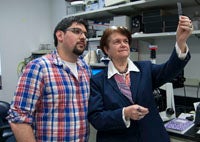Study On Anti-Epilepsy Drugs in Newborns

Posted in GUMC Stories
 Long after Karen Gale, Ph.D., a professor of pharmacology at Georgetown University Medical Center, began studying epilepsy, she gave birth to a daughter who experienced seizures as an infant. Gale knew enough about neonatal epilepsy and the drug used to treat the condition, that she was, as she says, “deeply concerned about the effects of anti-epilepsy drugs on the brain of a growing child.”
Long after Karen Gale, Ph.D., a professor of pharmacology at Georgetown University Medical Center, began studying epilepsy, she gave birth to a daughter who experienced seizures as an infant. Gale knew enough about neonatal epilepsy and the drug used to treat the condition, that she was, as she says, “deeply concerned about the effects of anti-epilepsy drugs on the brain of a growing child.”
Gale opted not to put her daughter on chronic drug therapy before she reached adolescence, choosing acute therapy instead.
This month, Gale and her colleagues including Patrick Forcelli, Ph.D., who worked in the Gale lab while obtaining his doctorate, published a study in the Annals of Neurology that is expected to raise serious questions about the use of certain anti-epilepsy drugs in newborns.
Their brain study, conducted in infant rats, demonstrates that the anti-epilepsy drug phenobarbital stunts neuronal growth, which could prompt new questions about using the first-line drug to treat epilepsy in human newborns. The drug, when given to rat pups about a week old, changed the way the animals’ brains were wired, causing cognitive abnormalities later in life.
 The researchers say it has been known that some of the drugs used to treat epilepsy increase the amount of neurons that die shortly after birth in the rat brain, but, until this study, no one had shown whether this action had any adverse impact on subsequent brain development.
The researchers say it has been known that some of the drugs used to treat epilepsy increase the amount of neurons that die shortly after birth in the rat brain, but, until this study, no one had shown whether this action had any adverse impact on subsequent brain development.
“Our study is the first to show that the exposure to these drugs ⎯ and just a single exposure ⎯ can prevent brain circuits from developing their normal connectivity, meaning they may not be wired correctly, which can have long-lasting effects on brain function,” says Gale. “These findings suggest that in the growing brain, these drugs are not as benign as one would like to believe.”
Epilepsy affects more than 300,000 Americans under the age of 15 and seizures in neonates are relatively common.
Stunted neuronal growth
Gale has been studying epilepsy for the past 30 years, and she has primarily focused on discovering the circuitry in the brain responsible for generating and controlling seizures. Her lab has had many firsts, such as discovering areas in the brain that can prevent a seizure or can trigger partial seizures.
About 10 years ago, she broadened her focus to the effects of anti-epilepsy drugs following a report suggesting several of these agents caused neuronal death in the neonatal rat brain. “The neonatal period is a stage when there is rapid neuronal growth and remodeling in the brain, and we suspected that the drugs were interfering with this important process,” she says.
Gale and Jinsook Kim, a Ph.D. student in the Interdisciplinary Program in Neuroscience (IPN), began looking at treatment effects on the developing brain, and when Kim graduated, Forcelli, also an IPN student, and Megan Janseen, Ph.D., continued this line of investigation, examining the functional consequences for both developmental physiology and behavior. Stefano Vicini, Ph.D., also contributed to the work.
Forcelli says the work suited his interests perfectly. As an undergraduate at Boston College, he studied epilepsy as well as early exposure to anti-depression drugs. “I became really interested in what might link early life drug exposure to later life behavioral consequences.”
Recent studies of IQ and other measurements of cognitive function in children have suggested that exposure to certain anti-epilepsy drugs, either in utero or infancy, affects brain function, but the issue is highly controversial, Forcelli says.
“Seizures do not happen to a normal healthy brain,” he says. “They are typically associated with, or are a result of, an injury or another neurological condition. So the issue is: what causes later deficits in function ⎯ the underlying condition, the seizures, or the drug used to treat the seizures or some combination of these?”
The Georgetown researchers say their study was designed to look directly at the effect of the different drugs on normal growth of brain neural networks in otherwise normal animals. This kind of study can only be performed in animal models, in which the drug effects can be examined separately from the effects of either seizures or other complications.
They measured communication between neurons in an area of the brain known to be sensitive to anti-epilepsy drugs in baby rats that were 10, 14, or 18 days old. In untreated rats, there was a dramatic increase in communication between neurons in this area during this eight-day period. But this maturation of neurons was not seen in rats that had been treated a week earlier with a single therapeutic dose of phenobarbital.
The researchers also tested the effect of the drugs after the pups reached early childhood, and found that those treated with phenobarbital were slow to learn.
The good news
The investigators tested four anti-epilepsy drugs in all, and found that some did not have the same effects as phenobarbital.
“The good news is that not all anti-epilepsy drugs have this disruptive effect in the animal studies,” Gale says. “This is valuable information ⎯ and is especially meaningful to me.”
Use of the drug levetiracetam did not stunt synaptic growth, and animals treated with lamotrigine, showed neural maturation, but it was delayed. An additional finding involved melatonin. When added to phenobarbital, it appeared to prevent the persistent adverse neural effects in the rat pups. Melatonin has been used clinically to protect cells from injury in humans.
“Many clinicians have been advocating for a reexamination of the use of these drugs in infants, and our findings provide experimental data to support that need,” says Forcelli.
“Phenobarbital has been used to treat seizures for over 100 years — well before a Food and Drug Administration approval process was established– and for more than 50 years, it has been the first drug of choice in the treatment of seizures in neonates.”
This kind of research matters, and the “highly collaborative neuroscience community at Georgetown” makes it possible to do this kind of investigation, Forcelli says. He plans to stay in academia, and run his own lab someday studying epilepsy. “It has been a part of my research from the first day I set foot in a lab.”
The study was funded by a predoctoral fellowship from the Epilepsy Foundation, a research grant from GlaxoSmithKline, grants from the National Institutes of Health (R21MHO79991, RO1MH64797), and National Institutes of Health training grants (T32DAoo7291 and T32NS041231).
By Renee Twombly, GUMC Communications
(Published May 16, 2012)
